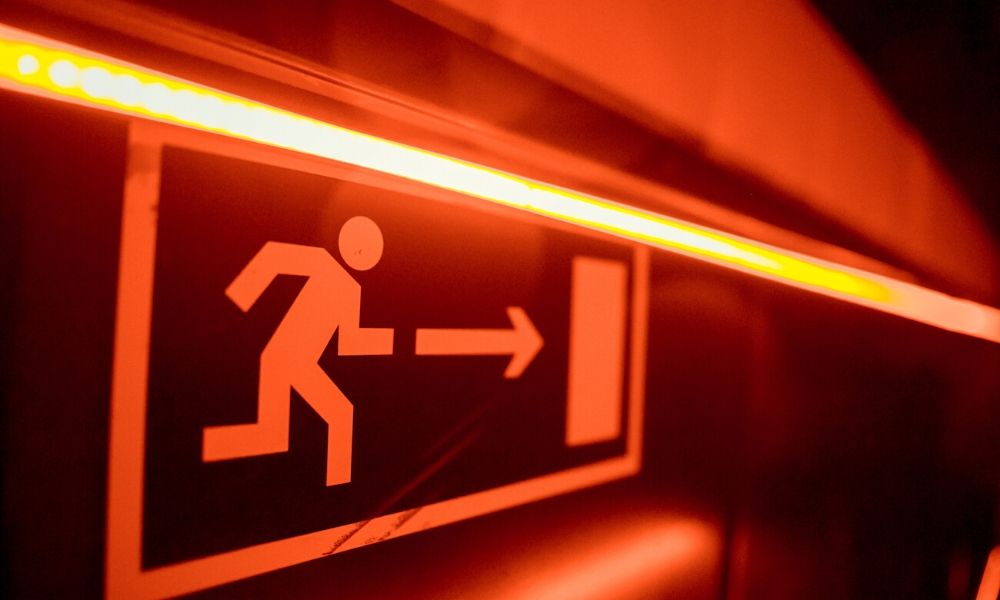Fire safety in public buildings has many essential components. Building owners and managers are responsible for keeping their visitors and workers safe from unnecessary hazards. Fire safety stretches beyond simply keeping your building up to code and installing fire alarms. Making sure your public building is as protected as possible from fires could be the difference between life and death for those in your building. Here is a guide to fire safety in public buildings.
Have escape routes planned out
Map out escape routes from every point in the building—this is especially important if your building is large, filled with hallways, or multiple stories tall. Make sure to leave no rooms vulnerable and clearly mark the closet exits to each room and area. Sometimes, during fires, some exit routes become blockaded or otherwise inaccessible. This makes planning alternative exit routes from each vantage point crucial. Each exit point should be plainly marked on your escape route map and in your building.
During fires, many people have trouble remaining calm enough to rationally think through and come up with active solutions when Plan A doesn’t pan out. Marking a second route option on your escape route map can save lives and circumvent that paralyzing panic.
Don’t leave any areas vulnerable. It’s easy to forget about escape plans for your buildings’ lesser-used rooms, such as utility closets, equipment rooms, and other spaces only staff typically uses. Create escape routes for each and every area, room, and location within your building, including those potentially forgotten areas.
Educate your employees
Make sure your building staff, especially safety officers, are informed about what to do if a fire occurs. The general public will look to your staff as authority figures during emergencies, so they should be ready to take charge and help others. They should know basic fire safety tips, where escape route maps are located, what the escape routes are for their room or area, and should always practice safety when using fire indoors.
Holding regular fire safety seminars with your building staff and educating them on how to keep calm and herd visitors out the proper door in an orderly fashion during a fire emergency is the best way to prepare your building for a fire.
Talk to your employees about proper fire use within your buildings. All building staff should be aware not to smoke inside. You should also talk to them about the dangers of leaving objects too close to a heat source, such as a space heater, heating vent, or any other item that exudes copious heat.
Another common mistake that causes building fires is fireplace misuse. Be sure that, if your building has any fireplaces, only staff who have been properly trained touch it. If lit improperly or set up incorrectly, you could be dealing with a large fire and a lot of smoke. To reduce the risk of improper lighting of non-electric fireplaces, you can invest in custom book matches purchased wholesale and get tailored fireplace lighting directions printed on the boxes. This will help remind employees of correct fireplace safety.
Have proper fire alarms in place
Your building should be up-to-code and have plenty of safety systems in place. An easy way to check your building’s fire safety and weaknesses is by asking your local fire department to inspect your building. They can quickly identify areas that need improvement, outdated features, and any major issues that should be addressed immediately.
If your building doesn’t have a sprinkler system or has an outdated one, research and pick out a new system that will work best for your building. These are especially important in buildings with frequent cooking and places that tend to become overcrowded often.
Test all of the fire alarms in your building regularly and change the batteries often. It can be helpful to keep a log of when each fire alarm’s batteries are changed, so it’s easier to keep track of. Time can fly, and without proper documentation, it may become troublesome to have to remember how old each alarm battery is. You should also have plenty of manual pull fire alarms. Often, an employee or bystander may stumble upon a fire long before the smoke sets the detector off. Knowing early increases the amount of time people have to evacuate, so the ability to simply pull a handle to alert the building can lead to saved lives.
Avoid electrical fires
Electrical fires are a leading cause of fire in buildings and have various causes, ranging from improper electrical wiring or design to human error. Electrical fires can be devastating and even result in explosions, so prevention is the best method of handling electrical fires.
Make sure not to overload outlets. Extension cords are not meant to be permanent fixtures in your building. Only put onto the outlet what it can handle. Check what voltage your outlet is built for and make it a point not to exceed that number with what you plug into it.
If you have an older building, have the wiring inspected. Chances are, your wiring is outdated and struggles to keep up with the large electrical demands of today. Even buildings built in the 1990s could have outdated wiring techniques or equipment, because builders then did not anticipate the extreme technological advances in the world today that require large amounts of electricity to function. If you find your wiring is outdated, it is worth the cost to update it. Updating your wiring could save lives and your building from a disaster.
Check your building’s breaker systems. If it continuously malfunctions, have a professional electrician take a look at it. Breaker system issues are a telltale sign of outdated wiring and electrical fire threats.
It is also important to remind employees not to throw water on the flames in the event of an electrical fire. Although this is typically the natural reaction to a fire breaking out, with electrical fires, water can endanger more lives and even worsen the flames in some cases.


